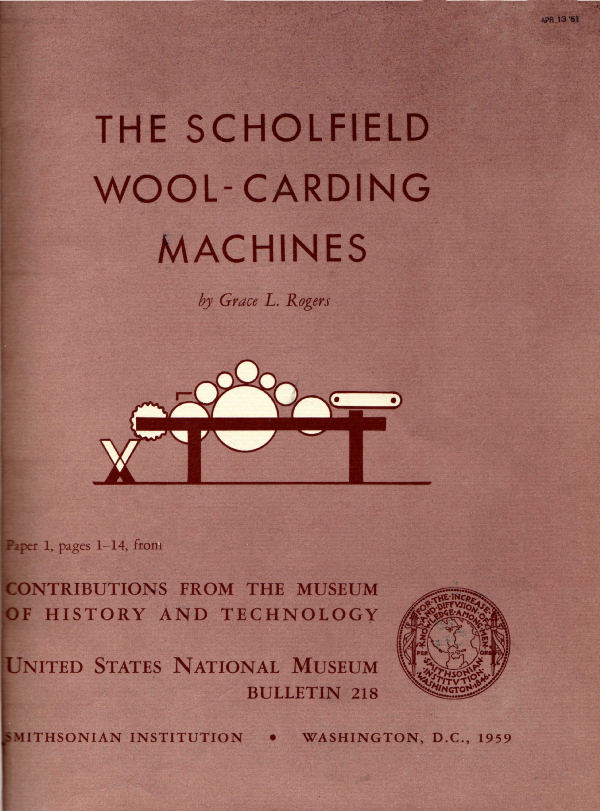
Contributions from
The Museum of History and Technology:
Paper 1
The Scholfield Wool-Carding Machines
Grace L. Rogers
| PRIMITIVE CARDING | 3 |
| THE FIRST MECHANICAL CARDS | 5 |
| JOHN AND ARTHUR SCHOLFIELD | 8 |
| THE NEWBURYPORT WOOLEN MANUFACTORY | 9 |
| THE SCHOLFIELD MACHINES | 12 |
 Figure 1.—An Original Scholfield Wool-CardingMachine, built by Arthur Scholfield or underhis immediate direction between 1803 and 1814, asexhibited in the hall of textiles of the U.S. NationalMuseum (cat. no. T11100). The exhibits in thishall are part of those being prepared for the enlargedhall of textiles in the new Museum of History andTechnology now under construction. (Smithsonianphoto 45396.)
Figure 1.—An Original Scholfield Wool-CardingMachine, built by Arthur Scholfield or underhis immediate direction between 1803 and 1814, asexhibited in the hall of textiles of the U.S. NationalMuseum (cat. no. T11100). The exhibits in thishall are part of those being prepared for the enlargedhall of textiles in the new Museum of History andTechnology now under construction. (Smithsonianphoto 45396.)By Grace L. Rogers
THE SCHOLFIELD
WOOL-CARDING
MACHINES
First to appear among the inventions that sparked the industrialrevolution in textile making was the flying shuttle, then variousdevices to spin thread and yarn, and lastly machines to card the rawfibers so they could be spun and woven. Carding is thus the importantfirst step. For processing short-length wool fibers itsmechanization proved most difficult to achieve.
To the United States in 1793 came John and Arthur Scholfield,bringing with them the knowledge of how to build a successful wool-cardingmachine. From this contribution to the technology of ourthen infant country developed another new industry.
The Author: Grace L. Rogers is curator of textiles, Museumof History and Technology, in the Smithsonian Institution's UnitedStates National Museum.
Carding is the necessary preliminary step bywhich individual short fibers of wool or cottonare separated and cleaned of foreign materials so theycan be spun into yarn. The thoroughness of the cardingdetermines the quality of the yarn, while the positionin which the carded fibers are laid determines itstype. The fibers are laid parallel in order to spin asmooth compact yarn, or they are crossed and intermingledto produce a soft bulky yarn.
Primitive Carding
The earliest method of carding wool was probablyone in which, by use of the fingers alone, the tufts werepulled apart, the foreign particles loosene